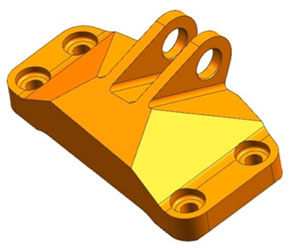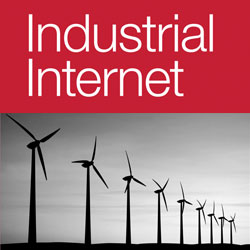OK, I admit to losing all sense of objectivity on this one! After all, it hits all my sweet spots:
- Internet of Things (AKA General Electric’s “Internet of Things”)
- 3-D printing
- crowdsourcing/collaboration.
As I wrote earlier, about GE’s collaboration with Electric Imp and Quirky, this exemplar of Industrial Age might (what could be more powerful than a GE locomotive???) really seems to get it that the Internet of Things is as much about new attitudes of collaboration and sharing data as it is about Internet technology.

GE jet engine mount
So it’s no surprise that Industry Week reports on a new GE initiative, soliciting crowdsourced designs for a new jet engine bracket that will be produced through 3-D printing.
As Christine Furstoss, technical director of Manufacturing and Material Technologies at GE Global Research, explains:
“‘For any industry to be successful, you really need to develop communities or ecosystems of partners and thought leaders…
‘No sustainable, established industry technology exists without multiple players, multiple styles of thought, multiple ways of growing … We feel like one of the best ways to stimulate that, to find the newest and best ideas, is to start with open collaboration.'”
Bravo!
Contrast that attitude with what is still all too prevalent, as summarized by Paul Horn, former senior vp of research at IBM:
“Horn remembers a time before open innovation — a competitive, suspicious era when innovative and great, transformative ideas were only allowed to grow in a tightly sealed vacuum.
‘When we built the Almaden Laboratory at IBM in the early 1980s, we put it south of Silicon Valley on purpose,’ he recalls. ‘In those days, our biggest fear was the leaking of intellectual property out into the valley.'”
I suspect that one of the biggest obstacles to full realization of the IoT’s promise will be the difficulty of leaving that old zero-sum game, my-gain-is-your-loss mentality behind!
I wasn’t aware that this latest competition, to design a 3-D printed bracket strong enough to support a jet engine on a commercial plane, is part of a 2-year crowdsourcing initiative, with approximately $20 million in prizes for products, designs and processes, especially in 3-D printing:
“‘We’re trying to find thought leaders in this area — people who may know through a technique they’ve devised or a piece of software that they’ve found or just their own experiences what is the best way to design with additive for real industrial parts,’ Furstoss explains. ‘We’re really at the birth of industrial additive technology. This is a way for us to build support for that community of makers.'”
Furstoss says the crowdsourcing competitions are no knock on GE’s own 50,000 engineers: “‘We have a platform in place that can put a student in his dorm on the same plane as our engineers,’ she says. ‘We’re making sure that people who may have ideas, may have skills, may have things to offer have an opportunity to bring them forward, no matter who they are.'”
It’s that kind of openness to not only new technologies, but also new management practices, that will give GE a huge head start over competitors that have yet to come to grips with the new reality: the Internet of Things!


